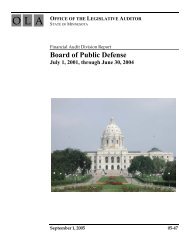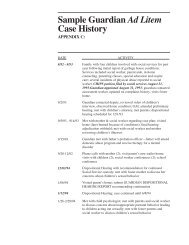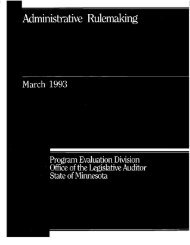Occupational Regulation - Office of the Legislative Auditor
Occupational Regulation - Office of the Legislative Auditor
Occupational Regulation - Office of the Legislative Auditor
Create successful ePaper yourself
Turn your PDF publications into a flip-book with our unique Google optimized e-Paper software.
18 OCCUPATIONAL REGULATION<br />
· Whe<strong>the</strong>r <strong>the</strong> practice <strong>of</strong> an occupation requires specific skill or training;<br />
and<br />
· Whe<strong>the</strong>r citizens could be protected by ano<strong>the</strong>r means. 54<br />
A fourth criterion was added in 1984:<br />
· Whe<strong>the</strong>r <strong>the</strong> overall cost effectiveness and economic impact would be<br />
positive for <strong>the</strong> citizens <strong>of</strong> <strong>the</strong> state. 55<br />
In addition to establishing criteria for occupational regulation, <strong>the</strong> 1976<br />
amendments mandated that occupations should be regulated in <strong>the</strong> least intrusive<br />
manner and directed <strong>the</strong> Legislature to consider a range <strong>of</strong> options in <strong>the</strong><br />
following order:<br />
· Creation or extension <strong>of</strong> common law and statutory causes <strong>of</strong> civil action<br />
and criminal prohibitions;<br />
· Imposition <strong>of</strong> inspections and <strong>the</strong> ability to enforce violations by injunctive<br />
relief in <strong>the</strong> courts;<br />
· Implementation <strong>of</strong> a registration system for <strong>the</strong> use <strong>of</strong> a designated title<br />
reflecting predetermined qualifications; and<br />
A 1976 law<br />
established a<br />
process in <strong>the</strong><br />
Minnesota<br />
Department<br />
<strong>of</strong> Health for<br />
studying<br />
proposals for<br />
regulating<br />
health<br />
pr<strong>of</strong>essions.<br />
· Implementation <strong>of</strong> a licensing system which allows practitioners meeting<br />
specific criteria to practice and prohibits o<strong>the</strong>rs from practicing.<br />
The 1976 legislation made o<strong>the</strong>r changes as well. It outlined <strong>the</strong> process <strong>of</strong><br />
receiving, investigating, and hearing consumer complaints against regulated<br />
pr<strong>of</strong>essionals. It also established a uniform procedure for regulatory bodies to<br />
follow for investigations and discipline. Since 1976 <strong>the</strong> complaint investigation<br />
process has been fur<strong>the</strong>r amended to actively involve representatives from <strong>the</strong><br />
<strong>Office</strong> <strong>of</strong> <strong>the</strong> Attorney General and allow for hearings before an administrative<br />
law judge, ra<strong>the</strong>r than before board members regulating <strong>the</strong> pr<strong>of</strong>ession. Ano<strong>the</strong>r<br />
change that followed from <strong>the</strong> 1976 legislation was <strong>the</strong> establishment <strong>of</strong> rules<br />
concerning health and human service related occupations.<br />
Regulating Health and Human Service<br />
Occupations: The Human Services Occupations<br />
Advisory Council<br />
Health-related pr<strong>of</strong>essions account for 34 <strong>of</strong> <strong>the</strong> 86 occupations regulated by<br />
independent boards in Minnesota. Additionally, <strong>the</strong> Department <strong>of</strong> Health<br />
regulates 8 clinical health occupations and 17 public and environmental health<br />
54 Minn. Laws (1976), ch. 222, sec. 1.<br />
55 Minn. Laws (1984), ch 654, art 5, sec. 9.








